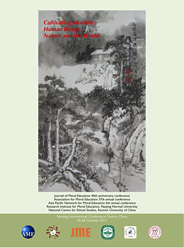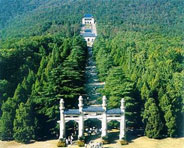Nanjing (南京)
Map | Wikipedia | Location on Google Maps
Nanjing, dating from 472 BC and the capital city during ten periods of Chinese history, is famed for its rich culture, long history and beautiful landscape. As a result of its long history, three cultures with distinctive characteristics may be witnessed in Nanjing: those of the Six Dynasties, the Ming Dynasty, and the Republic of China. These eras left behind many famous attractions including: the willowed banks of Xuanwu Lake, the river scenery of Confucius Temple, the ancient city wall (said to be the best preserved in the world), the World Heritage-listed Ming Tombs, Dr. Sun Yat-sen's Mausoleum, the Presidential Palace and many other places of historical and cultural interest, 14 of which are protected at the national level and 135 at the provincial level. The main tourist and scenic areas are listed below.
Zhongshan Hill Scenic Area
Situated in the eastern suburb of Nanjing, this is the most prestigious sightseeing area of the city, covering more than 50 major sites such as Dr. Sun Yat-sen's Mausoleum, Xiaoling Tomb of the Ming Dynasty, Plum Blossom Hill, Purple Mountain Observatory, Nanjing Botanical Garden, Linggu Temple, Xuanwu Lake Park, Tiacheng Wall, Jiuhuashan Park and Jiming Temple.
Qinhuai Scenic Area
Situated in the south of Nanjing, this area, covering the Qinhuai River's inner strip from Dongshui Pass in the east to the Xishui Pass in the west, has many scenic spots including Confucius Temple-Qinhuai Scenic Zone, Zhanyuan Garden, and the Urn City of Zhonghua Gate.
Stone City Scenic Area
This area in downtown Nanjing has mostly cultural sites, including: the Stone City, Presidential Palace, Mochou Lake, Ganjia Lane Stone Sculptures of the Southern Dynasties, Chaotian Palace, Villa Area on Yihe Road built during the time of the Republic of China, Jinling Sutra Printing House and the Former Residence of Ganxi.
The Great River Scenic Area
Nanjing bestrides the Yangtze River, with a string of magnificent riverbank views that consist of Nanjing Yangtze River Bridge, Yuejiang Tower, Yanzi (Swallow) Rock, Jiangxinzhou Island, Jinghai Temple, Tianfei Palace, and Ruins of Baochuan Shipyard at Longjiang.
Qixia Scenic Area
Situated in the northeastern suburb of Nanjing, this area is famous for its red maple view and the 1000-year-old Qixia Temple, especially favoured for an autumn hike.
Scenic Area in Southern Suburbs
In this beautiful scenic area there are numerous historic sites, such as the Yuhuatai (Rain Flower Terrace), Niushou Mountain, Two Tombs of the Southern Tang King, the Leaning Tower of Fangshan Hill and the tomb of the King of Brunei.
Scenic Area around the Gucheng Lake and Shijiu Lake
Situated in Gaochun County and Lishui County, this area has scenic sites such as Yanzhi (Rouge) River, Tiansheng Bridge, Gucheng Lake, Gaochun Ancient Street and Fujiabian Ecological Agriculture Garden.
Scenic Area in Jiangpu and Pukou
In this garden area across the Yangtze River facing Nanjing City there are sites such as the Pearl Spring and Laoshan National Forest Park.
Tangshan Scenic Area
Located in Jiangning County, this area has famous hot springs and the Yangshan Hill Stele. Nanjing Tangshan Ape-man was also discovered here.



